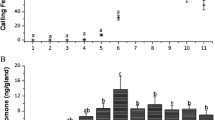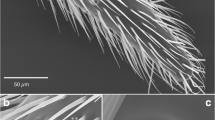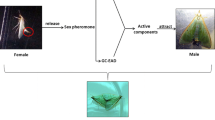Abstract
In many insects, mate finding is mediated by volatile sex pheromones, but evidence for this phenomenon in triatomines (Heteroptera: Reduviidae) is still fragmentary. Recently, it was shown that metasternal glands (MGs) are involved in producing signals related to the sexual communication of Triatoma infestans and Rhodnius prolixus. Based on this, we tested whether MG volatiles could be involved in the sexual communication of Triatoma brasiliensis. Odor-mediated orientation responses were studied by using a T-tube olfactometer. These tests showed that males exhibit positive anemotaxis when confronted with adult odor-laden air currents. Moreover, females that had their metasternal glands occluded did not elicit significant orientation by males. Compounds produced by the MGs of T. brasiliensis females were identified by means of SPME, GC-FID, and GC-MS, with achiral and chiral columns. All substances identified were ketones and alcohols, and similar compound profiles were found in the secretions produced by both sexes. The most abundant compounds identified were 3-pentanone, followed by (4R)-methyl-1-heptanol, 3-pentanol, and (2S)-methyl-1-butanol. In addition, GC-EAD recordings showed that the antennae of males responded to several of the main components of female MG secretions. Our results showed that compounds produced by the MGs of T. brasiliensis females are involved in the sexual communication of this species.





Similar content being viewed by others
References
Alencar, J. E. 1987. História natural da doença de Chagas no Estado do Ceará, Fortaleza. Imprensa Universitária da Universidade Federal do Ceará, Fortaleza, Brazil.
Baeckström, P., Stridh, K., Li, L., and Norin, T. 1987. Claisen rearrangements with mesityl oxide dimethyl ketal. Synthesis of ipsdienone, E- and Z-ocimenone, 2,6-dimethyl-2,7-octadien-4-one and 2,6-dimethyl-2,7-octadien-4-ol. Acta Chem. Scand. B 41:442–447.
Baeckström, P., Li, L., Polec, I., Unelius, C. R., and Wimalasiri, W. R. 1991. Convenient method for the synthesis of lineatin, a pheromone component of Trypodendron lineatum. J. Org. Chem. 56:3358-3362.
Baldwin, W. F., Knight, A. G., and Lynn, K. R. 1971. A sex pheromone in the insect Rhodnius prolixus (Hemiptera: Reduviidae). Can. Entomol. 103:18-22.
Barth, S., and Effenberger, F. 1993. Lipase-catalyzed resolution of racemic 2-alkyl substituted 1-alkanols, Tetrahedron Asymmetry. 4:823-833.
Bestmann, H. J., and Vostrowsky, O. 1974. Pheromone III: Eine stereoselektive Synthese von 7,8-z-epoxy-2-methyloctadecan, dem Sexuallockstoff des Schwammspinners (Lymantria dispar, Porthetria dispar, Lepidoptera). Tetrahedron Lett. 15:207-208.
Brindley, M. D. H. 1930. On the metasternal scent glands of certain Heteroptera. Trans. Ent. Soc. Lond. 78:199-208.
Chen, Z., Chen, H., Hu, H., Yu, M., Li, F., Zhang, Q., Zhou, Z., Yi, T., and Huang, C. 2008. Versatile synthesis strategy for carboxylic acid-functionalized upconverting nanophosphors as biological labels. J. Am. Chem. Soc. 130:3023-3029.
Crespo, J., and Manrique, G. 2007. Mating behavior of the hematophagous bug Triatoma infestans: Role of Brindley's and metasternal glands. J. Insect Physiol. 53:708-714.
Cruz-López, L., Morgan, E. D., and Ondarza, R. N. 1995. B rindley’s gland exocrine products of Triatoma infestans. Med. Vet. Entomol. 9:403-406.
De Brito Sánchez, M. G., Manrique, G., and Lazzari, C. R. 1995. Existence of a sex pheromone in Triatoma infestans (Hemiptera: Reduviidae) II. Electrophysiological correlates. Mem. Inst. Oswaldo Cruz 90:649-651.
El-Sayed, A. M. 2008. The pherobase: database of insect pheromones and semiochemicals. http://www.pherobase.com.
Espínola, H. N. 1966. Nota sobre as diferenças sexuais em formas imaturas de Triatominae (Hemiptera: Reduviidae). Rev. Bras. Biol. 26:263-267.
Fontán, A., Audino, P. G., Martinez, A., Alzogaray, R. A., Zerba, E. N., Camps, F., and Cork, A. 2002. Attractant volatiles released by female and male Triatoma infestans (Hemiptera: Reduviidae), a vector of Chagas disease: chemical analysis and behavioral bioassay. J. Med. Entomol. 39:191-197.
Guerenstein, P. G., and Guerin, P. M. 2004. A comparison of volatiles emitted by adults of three triatomine species. Entomol. Exp. Appl. 111:151-155.
Hedenström, E., Nguyen, B. V., and Silks, L. A. 2002. Do enzymes recognise remotely located stereocentres? Highly enantioselective Candida rugosa lipase-catalysed esterification of the 2- to 8-methyldecanoic acids, Tetrahedron Asymmetry. 13:835-844.
Higashimura, T., Sawamoto, M., Hiza, T., Karaiwa, M., Tsuchii, A., and Suzuki, T. 1983. Effect of methyl substitution on microbial degradation of linear styrene dimers by two soil bacteria. Appl. Environ. Microbiol. 46:386-391.
Kováts, E. 1965. Gas chromatographic characterization of organic substances in the retention index system, pp. 229-247, in J. C. Giddings and R. A. Keller (eds.). Advances in Chromatography, vol. 1. Edward Arnold Ltd., London.
Larsson, M., Nguyen, B. V., Högberg, H. E., and Hedenström, E. 2001. Synthesis of the sixteen stereoisomers of 3,7,11-trimethyl-2-tridecanol, including the (2S,3S,7S,11R) and (2S,3S,7S,11S) stereoisomers identified as pheromone precursors in females of the pine sawfly Microdiprion pallipes (Hymenoptera: Diprionidae). Eur. J. Org. Chem. 2:353-363.
Lemieux, R. U., and Rudloff, E. V. 1955. Periodate-permanganate oxidations. Can. J. Chem. 33:1701-1709.
Manrique, G., and Lazzari, C. R. 1994. Sexual behavior and stridulation during mating in Triatoma infestans (Hemiptera: Reduviidae). Mem. Inst. Oswaldo Cruz 89:629-633.
Manrique, G. and Lazzari, C. R. 1995. Existence of sex pheromone in Triatoma infestans (Hemiptera: Reduviidae): I-Behavioral Evidence. Mem. Inst. Oswaldo Cruz 90:645-648.
Manrique, G., Vitta, A. C., Ferreira, R. A., Zani, C. L., Unelius, C. R., Lazzari, C. R., Diotaiuti, L., and Lorenzo, M. G. 2006. Chemical communication in Chagas disease vectors. Source, identity, and potential function of volatiles released by the metasternal and Brindley's glands of Triatoma infestans adults. J. Chem. Ecol. 32:2035-2052.
NIST 2002. The NIST mass spectral search program for the NIST/EPA/NIH mass spectral library.
Overberger, C. G., and Kaye, H. 1967. The synthesis of some optically active ε-caprolactones. J. Am. Chem. Soc. 89:5640-5645.
Pires, H. H. R., Lorenzo, M. G., Lazzari, C. R., Diotaiuti, L., and Manrique, G. 2004. The sexual behavior of Panstrongylus megistus (Hemiptera, Reduviidae): an experimental study. Mem. Inst. Oswaldo Cruz 99:295-300.
Pontes, G. B., Bohman, B., Unelius, C. R., and Lorenzo, M. G. 2008. Metasternal gland volatiles and sexual communication in the triatomine bug, Rhodnius prolixus. J. Chem. Ecol. 34:450-457.
Reiter, B., Burger, B. V., and Dry, J. 2003. Mammalian exocrine secretions. XVIII: Chemical characterization of interdigital secretion of red hartebeest, Alcelaphus buselaphus caama. J. Chem. Ecol. 29:2235-2252.
Rojas, J. C., Malo, E. A., Gutierrez-Martinez, A., Ondarza, R. A. 1990. Mating behavior of Triatoma mazzottii Usinger (Hemiptera: Reduviidae) under laboratory conditions. Ann. Entomol. Soc. Am. 83:598–602.
Rojas, J. C., Rios-Candelaria, E., Cruz López, L., Santiesteban, A., Bond-Compean, J. G., Brindis, Y., and Malo, E. A. 2002. A reinvestigation of Brindley’s gland exocrine compound of Rhodnius prolixus (Hemiptera: Reduviidae). J. Med. Entomol. 39:256-265.
Tai, A., Syouno, E., Tanaka, K., Fujita, M., Sugimura, T., Higashiura, Y., Kakizaki, M., Hara, H., and Naito, T. 2002. Regio- and stereochemical study of sex pheromone of pine sawfly; Diprion nipponica. Bull. Chem. Soc. Jpn. 75:111-121.
Tang, R., Webster, F. X., and Müller-Schwarze, D. 1995. Neutral compounds from male castoreum of North American beaver, Castor canadensis. J. Chem. Ecol. 21:1745-1762.
Vitta, A. C. R., and Lorenzo, M. G. 2009. Copulation and mate guarding behavior in Triatoma brasiliensis. J. Med. Entomol. 46:789-795.
Ward, J. P. 1981. A comparison of the behavioral responses of the haematophagous bug, Triatoma infestans to synthetic homologues of two naturally occurring chemicals (n- and isobutyric acid). Physiol. Entomol. 6:325-329.
WORLD HEALTH ORGANIZATION. 2005. Report of the Scientific Working Group on Chagas Disease. http://www.who.int/tdr/diseases/chagas/default.htm.
Acknowledgements
The authors are grateful to FAPEMIG, CNPq and FIOCRUZ for financial support. This work was also supported by the Swedish International Development Cooperation Agency (SIDA), and by the University of Kalmar (Sweden). The New Zealand Institute for Plant & Food Research Limited, Lincoln, New Zealand provided some research facilities for BB and CRU. ACRV wishes to thank Mr. Arnaldo Aroeira for his kind support on drawing the olfactometer scheme.
Author information
Authors and Affiliations
Corresponding author
Rights and permissions
About this article
Cite this article
Vitta, A.C.R., Bohman, B., Unelius, C.R. et al. Behavioral and Electrophysiological Responses of Triatoma brasiliensis Males to Volatiles Produced in the Metasternal Glands of Females. J Chem Ecol 35, 1212–1221 (2009). https://doi.org/10.1007/s10886-009-9709-2
Received:
Revised:
Accepted:
Published:
Issue Date:
DOI: https://doi.org/10.1007/s10886-009-9709-2




